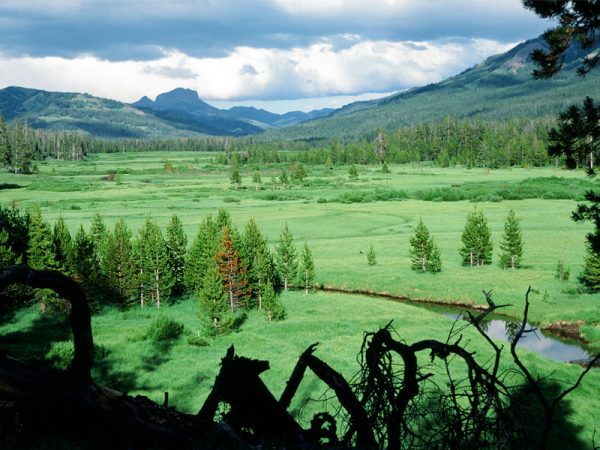The Teton Wilderness Area lies to the west of the Great Divide. The land is dominated by timbered ridges, grassy slopes, and broad willow and sedge meadows with elevations from 7,000 feet to 9,675 feet. To the east of the Great Divide are high alpine plateaus broken by ridges and extensive mountain meadows with elevations from 8,000 feet to 12,165 feet (Younts Peak).The United States Congress designated the Teton Wilderness in 1964 and it now has a total of 585,238 acres.
Teton Wilderness Area
The state’s second largest Wilderness area straddles the Continental Divide deep in the heart of Wyoming’s Yellowstone Ecosystem. It is bordered on the north by Yellowstone National Park, on the east by Washakie Wilderness, on the west by Grand Teton National Park, and on the south by the Mt Leidy Highlands and Gros Ventre Wilderness.
All of this wilderness is located in Wyoming and is managed by the Forest Service. The Teton Wilderness is bordered by the Washakie Wilderness to the east.
On Two Ocean Pass, the famous Two Ocean Creek splits to send water to both the Atlantic and the Pacific Oceans. Within the Teton Wilderness the headwaters of the notable Yellowstone and Snake Rivers arise in alpine meadows of willow and sedge.
You’ll see evidence of the great fires from the summer of 1988 that burned here and in Yellowstone.
In 1987 the highest elevation tornado ever recorded mowed a 20-mile-long, two-mile-wide swath through an area near Enos Lake. But in general, this area is vast, spectacular, and relatively unspoiled.
Teton Wilderness ranks among this nation’s best wildlife areas. Summer brings trumpeter swans, sandhill cranes, ducks, geese, falcons, and song birds. Grizzly bears, grey wolves, moose and elk wander across meadows. Golden and bald eagles, hawks, grouse, coyotes, beavers, martens, bobcats, porcupines, otters, and mink live here year-round.
Approximately 450 miles of trails provide access to this popular area. About half of the visitors to this area come expressly to hunt and fish. Home to numerous large predators, Grizzly and Black Bears, Grey Wolves, and Mountain Lion, it is strongly recommend that all visitors take precautions and come prepared to recreate accordingly.
Regulations in the Teton Wilderness
ALL VISITORS
1) Maximum party size is 20 people.
2) Possessing or placing salt for the purpose of attracting wildlife is prohibited. Salt may be used for culinary purposes in camp, or for pack and saddle stock in livestock feeding locations near camp.
3) Food, carcasses, and all bear attractants must be acceptably stored.
4) Camping within 200 feet of lake or designated trail or 100 feet from streams is prohibited. This includes tethering or picketing of stock.
5) The maximum length of stay is 16 days. After 16 days camps must be moved at least 5 air miles from the original site. After leaving you cannot return to the site for at least 7 days.
6) Campsites, food, or equipment (caches) may not be left unattended for more than 48 hours.
7) Shortcutting a switchback in a trail is prohibited.
8) Camping is prohibited in the lower Atlantic Cr. area described as T48N R11W E 1/2 of Sec 36; T48N R110W NW 1/4 Sec 31.
STOCK USERS
1) Maximum number of stock is 35 head.
2) All hay and straw must be certified as weed seed free. Each bale must be twined, tagged, or labeled as weed seed free and reference the written certification.
3) Horse grazing within 1/2 mile of Enos, Bridger, Crater, Rainbow, Bertha, Golden, Mackinaw, and Ferry lakes is prohibited.
4) Tying livestock to trees for long periods of time that causes injury or damage to the tree, vegetation, or soil. At rest stops, tie stock to mature trees that are at least 8 inches in diameter.

